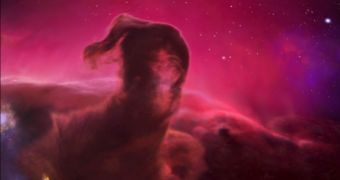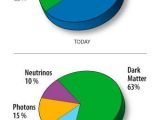The universe is certainly not empty, that's a fact, but its not very dense either. Today, the visible universe consists mostly of empty space, void, while ordinary matter accounts for only 4 percent of the total mass. So where is the rest of 95 percent of the universe's mass? In dark energy and dark matter, according to some physical theories. Further still, the void doesn't seem to be so empty after all, but filled with an ocean of elementary sub-atomic and weakly interacting particles.
Part of these are supposed to have originated in the first few seconds after what we now call the Big Bang event, when the universe was created while others where formed by conversion from other elementary particles. For example, the Sun in burning molecular hydrogen gas through a process of nuclear fusion which results in the release of massive quantities of energy and elements superior to hydrogen. Part of that energy is taken by neutrinos which basically fills the whole space around us.
Neutrino particles are a by-product of the nuclear fusion reactions which take place in the Sun's core. They have extremely low mass - not yet calculated, no charge and weak interactions towards ordinary matter. We might not feel it, but through a finger tip pass more than 100 million neutrino particles each second, pretty much meaning that, if they were visible to human eyes, the fall of neutrino particles would look like the worst snow storm ever! They can pass through the whole mass of the Earth, and the Sun for that matter, without being even slightly deviated from their original trajectory.
NASA's Wilkinson Microwave Anisotropy Probe confirms the theory laid out by physicists, the void space of the universe is filled with a fluid of cold neutrinos, totally separated from the ordinary matter. During the first moments of the universe's life, while it was still very dense and hot, some of these neutrinos could have been created by collisions between highly energetic elementary particles. Thus, only two seconds after the Big Bang event, the large majority of particles would have lost enough energy to interact with neutrinos, and remain so even to this day.
The remnant particles should still exist even today all around us, having an energy equivalent to a temperature close to absolute zero, more precisely 1.9 degrees Celsius. During a survey involving the probing of the Cosmic Background Radiation, the WMAP spacecraft detected what seems to be evidence of the existence of such particles in a signature that originated about 380,000 years after the Big Bang, showing the development of density fluctuations in the matter distribution in the universe, the so-called textures.
According to theory, the presence of the neutrinos particles should have stopped the formation of matter accumulations in certain locations of the universe, smoothing the matter distribution in the process. The WMAP confirms this by showing that neutrinos could have represented 10 percent of the total energy of the universe, in that period of time.
The study has been conducted by Eiichiro Komatsu from the University of Texas. Additionally, another study was released in 2005, nearly 4 years after the discoveries made by the WMAP spacecraft, proving that a Cosmic Neutrino Background does indeed exist.
The problem with detecting neutrinos is that they interact very weakly with ordinary matter, but if traditional detection methods fail, we could always turn towards the CMB for some additional help. The usual technique used to detect neutrinos involves the use of massive tanks of heavy water buried deep underground. Every now and then, one of these elusive particles stops and interacts with heavy water molecules ejecting a photon particle of light in the process.
On the other hand, neutrino particles originating 380,000 years after the Big Bang should in fact have energies one million times smaller than that of neutrinos emitted from the Sun's central core. To stop completely a large number of neutrino particles at the same time, scientists approximate that they would require a shield at least one light year thick, while in the case of CNB radiation, even a block of lead as big as the whole universe might not be enough. As far as we know, no naturally occurring massive cosmic object can have a radius of one light year.

 14 DAY TRIAL //
14 DAY TRIAL // 
